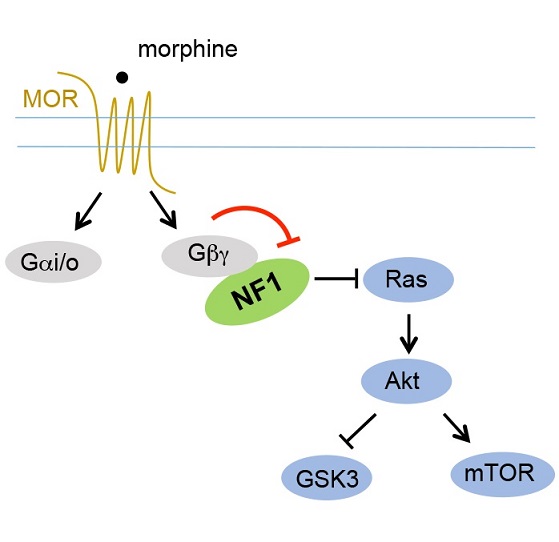Neurofibromatosis
Opioid Receptor Signaling Crosstalk to Ras Protein is Mediated by Neurofibromin 1



Posted February 3, 2017
Kirill A. Martemyanov, Ph.D., The Scripps Research Institute

Kirill A. Martemyanov, Ph.D.,
The Scripps Research Institute
Photo used with permission of Dr. Martemyanov
The Scripps Research Institute
Photo used with permission of Dr. Martemyanov
Signaling through G protein-coupled receptors (GPCRs) plays a major role in neurons for many processes, including neurotransmitter signaling, and the mechanisms for crosstalk between pathways are still largely unknown. GPCR activation has long been known to transactivate the Ras pathway; while there are molecules suspected to mediate this, their roles seem to be specific to certain cell types, and the molecules that act as mediators in neurons are currently unknown. Dr. Kirill Martemyanov of The Scripps Research Institute in Florida received a fiscal year 2013 (FY13) New Investigator Award from the Neurofibromatosis Research Program (NFRP) to study the role of Neurofibromin 1 (NF1) in the crosstalk between GPCR signaling and other signaling pathways in the cell. In work recently published in part with the support of this award, he examined the function of NF1 in mu-opioid receptor (MOR) signaling and Ras activation in striatal neurons.
Dr. Martemyanov and his colleagues found that NF1 binds directly to a signaling component that dissociates from MORs upon morphine stimulation, and this interaction prevents NF1 from inhibiting Ras activation and downstream Akt-mTOR/GSK3-beta kinase signaling. Further, they found that MORs could not signal to Ras without the presence of NF1. In behavioral studies with mice with striatal-specific knockout of NF1, the research group found that, although the mice had mostly normal reactions to open field tests, administration of morphine to the mice led to lower psychomotor activation, compared to mice with NF1, without affecting the timing and duration of the activation. Interestingly, there was no observable difference in the analgesic effect of morphine in these mice. Dr. Martemyanov and his colleagues also tested the mice for reward-related and reinforcement behaviors. They found that lack of NF1 in the striatal cells led to decreased sensitivity of the mice to morphine reward and the reinforcing effects of morphine.
Mutations in the gene NF1 lead to the disorder neurofibromatosis Type 1; among the many manifestations of this disorder are learning challenges and pain. The work presented by Dr. Martemyanov and his group demonstrating the role of NF1 in opioid signaling to Ras in striatal neurons may lend to understanding these related aspects of neurofibromatosis and could provide insight to new avenues of therapy.

Xie K, et al. 2016. NF1 Is a Direct G Protein Effector Essential for Opioid Signaling to Ras in the Striatum, Current Biology, Nov 21; 2(22):2993-3003.
Link:
Last updated Thursday, December 5, 2024














